Ethics and Decision-Making: Exploring Ethical Dilemmas in Business
VerifiedAdded on 2021/05/31
|8
|2205
|14
Report
AI Summary
This report examines ethical decision-making through two case studies. The first case involves an accountant, Johnny, who violates ethical principles by backdating and inserting a document, highlighting issues of honesty, integrity, and the importance of financial report accuracy. The second case involves Mary Jo, who violates academic integrity by downloading exams. The report analyzes the stakeholders involved, including managers, auditors, customers, and university management, and discusses the ethical implications of these actions. It emphasizes the need for ethical thinking in organizations and suggests alternative actions for Johnny and Mary Jo, recommending that Johnny should have spoken up about the missing documents and Mary Jo should have avoided downloading the exams. The report concludes by emphasizing the impact of ethical dilemmas on reputation and the importance of making decisions that uphold ethical virtues.
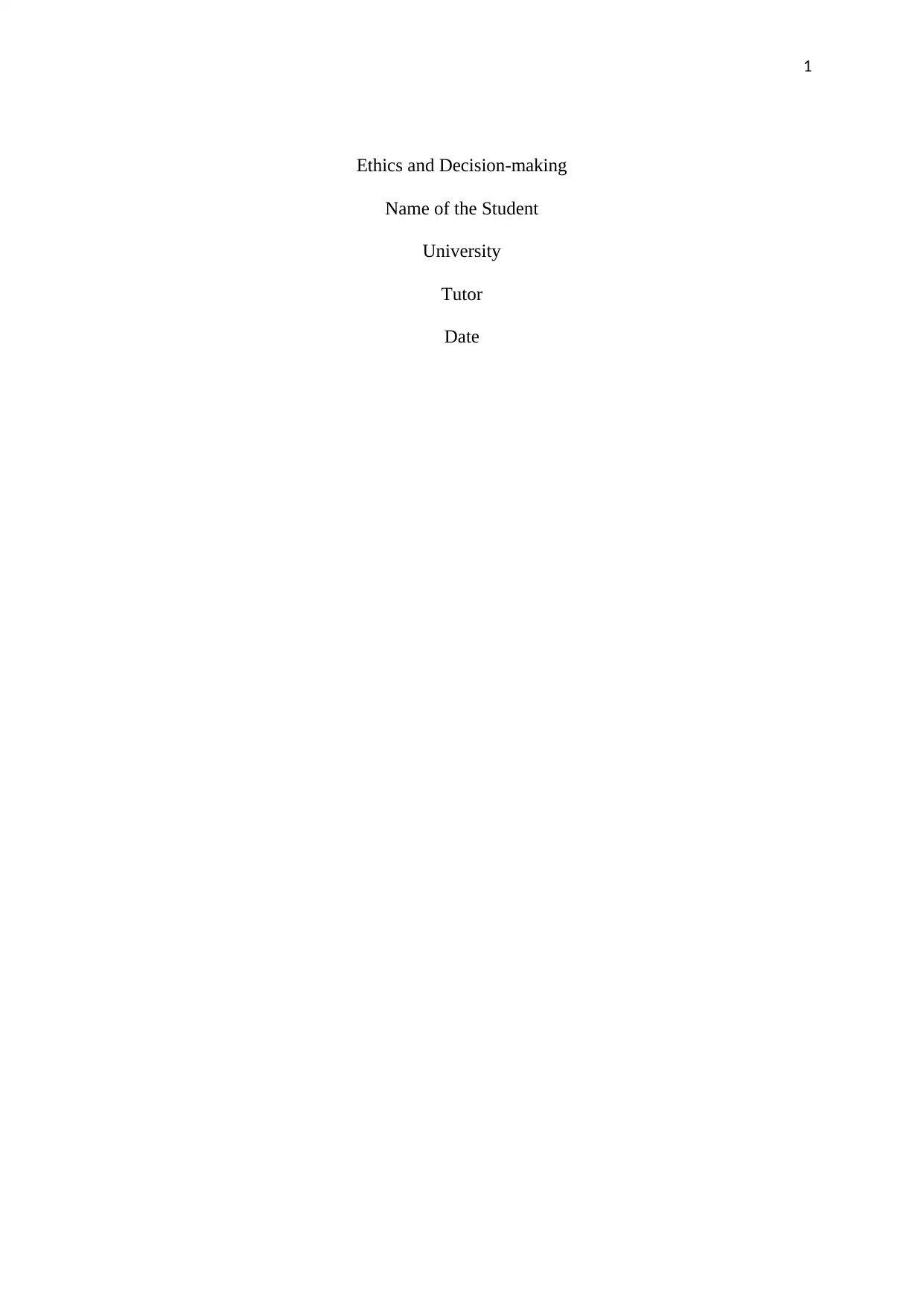
1
Ethics and Decision-making
Name of the Student
University
Tutor
Date
Ethics and Decision-making
Name of the Student
University
Tutor
Date
Paraphrase This Document
Need a fresh take? Get an instant paraphrase of this document with our AI Paraphraser
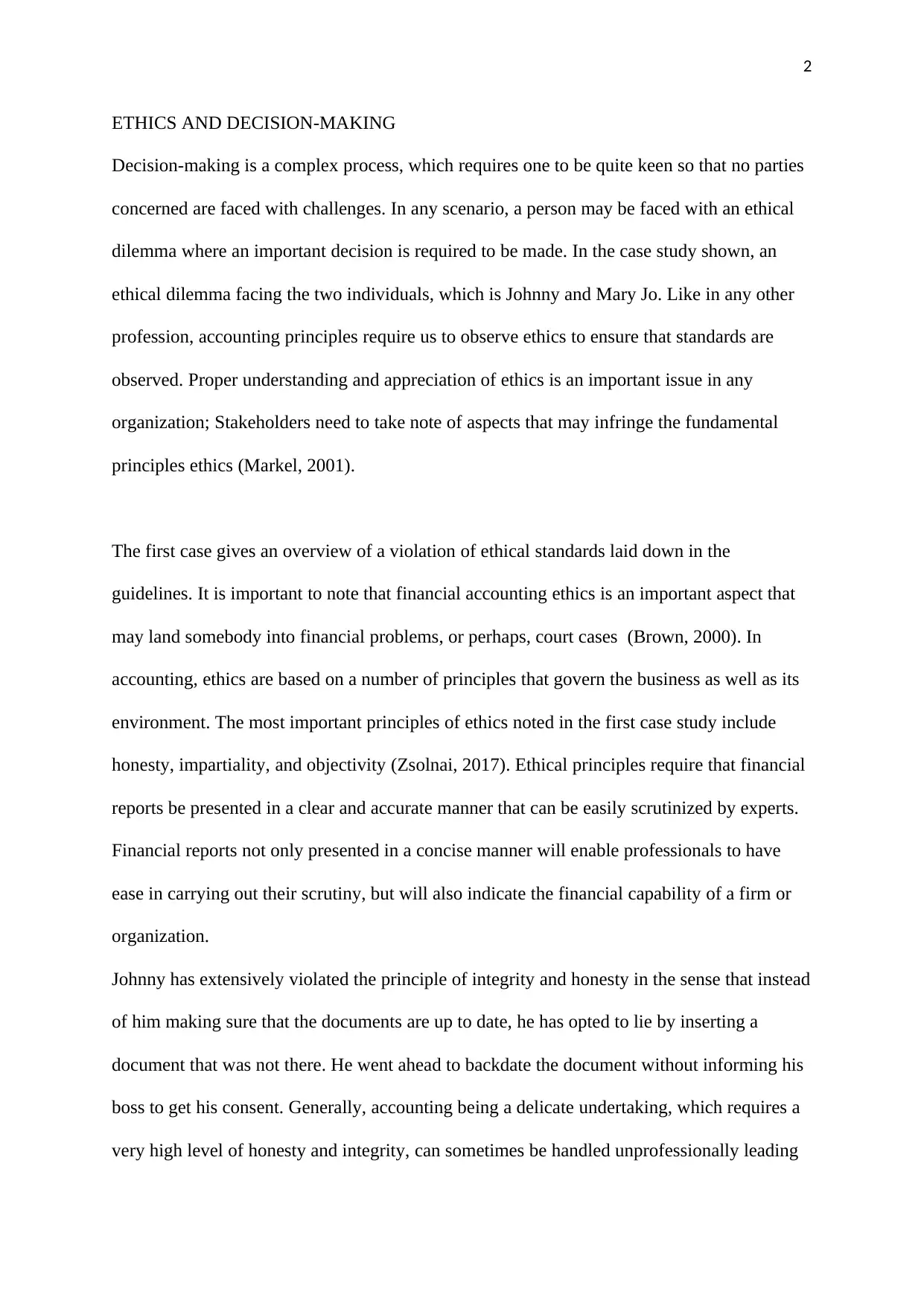
2
ETHICS AND DECISION-MAKING
Decision-making is a complex process, which requires one to be quite keen so that no parties
concerned are faced with challenges. In any scenario, a person may be faced with an ethical
dilemma where an important decision is required to be made. In the case study shown, an
ethical dilemma facing the two individuals, which is Johnny and Mary Jo. Like in any other
profession, accounting principles require us to observe ethics to ensure that standards are
observed. Proper understanding and appreciation of ethics is an important issue in any
organization; Stakeholders need to take note of aspects that may infringe the fundamental
principles ethics (Markel, 2001).
The first case gives an overview of a violation of ethical standards laid down in the
guidelines. It is important to note that financial accounting ethics is an important aspect that
may land somebody into financial problems, or perhaps, court cases (Brown, 2000). In
accounting, ethics are based on a number of principles that govern the business as well as its
environment. The most important principles of ethics noted in the first case study include
honesty, impartiality, and objectivity (Zsolnai, 2017). Ethical principles require that financial
reports be presented in a clear and accurate manner that can be easily scrutinized by experts.
Financial reports not only presented in a concise manner will enable professionals to have
ease in carrying out their scrutiny, but will also indicate the financial capability of a firm or
organization.
Johnny has extensively violated the principle of integrity and honesty in the sense that instead
of him making sure that the documents are up to date, he has opted to lie by inserting a
document that was not there. He went ahead to backdate the document without informing his
boss to get his consent. Generally, accounting being a delicate undertaking, which requires a
very high level of honesty and integrity, can sometimes be handled unprofessionally leading
ETHICS AND DECISION-MAKING
Decision-making is a complex process, which requires one to be quite keen so that no parties
concerned are faced with challenges. In any scenario, a person may be faced with an ethical
dilemma where an important decision is required to be made. In the case study shown, an
ethical dilemma facing the two individuals, which is Johnny and Mary Jo. Like in any other
profession, accounting principles require us to observe ethics to ensure that standards are
observed. Proper understanding and appreciation of ethics is an important issue in any
organization; Stakeholders need to take note of aspects that may infringe the fundamental
principles ethics (Markel, 2001).
The first case gives an overview of a violation of ethical standards laid down in the
guidelines. It is important to note that financial accounting ethics is an important aspect that
may land somebody into financial problems, or perhaps, court cases (Brown, 2000). In
accounting, ethics are based on a number of principles that govern the business as well as its
environment. The most important principles of ethics noted in the first case study include
honesty, impartiality, and objectivity (Zsolnai, 2017). Ethical principles require that financial
reports be presented in a clear and accurate manner that can be easily scrutinized by experts.
Financial reports not only presented in a concise manner will enable professionals to have
ease in carrying out their scrutiny, but will also indicate the financial capability of a firm or
organization.
Johnny has extensively violated the principle of integrity and honesty in the sense that instead
of him making sure that the documents are up to date, he has opted to lie by inserting a
document that was not there. He went ahead to backdate the document without informing his
boss to get his consent. Generally, accounting being a delicate undertaking, which requires a
very high level of honesty and integrity, can sometimes be handled unprofessionally leading
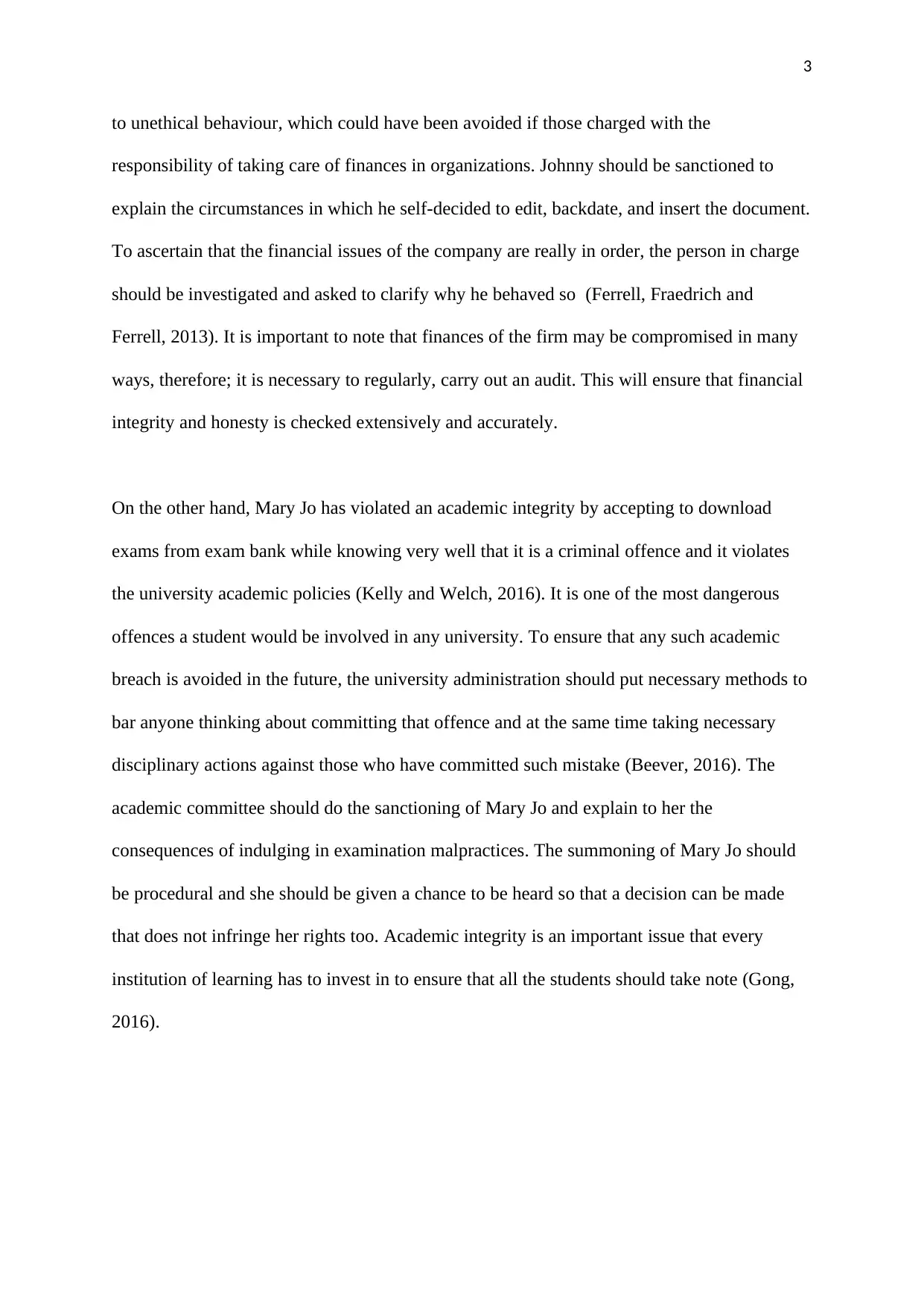
3
to unethical behaviour, which could have been avoided if those charged with the
responsibility of taking care of finances in organizations. Johnny should be sanctioned to
explain the circumstances in which he self-decided to edit, backdate, and insert the document.
To ascertain that the financial issues of the company are really in order, the person in charge
should be investigated and asked to clarify why he behaved so (Ferrell, Fraedrich and
Ferrell, 2013). It is important to note that finances of the firm may be compromised in many
ways, therefore; it is necessary to regularly, carry out an audit. This will ensure that financial
integrity and honesty is checked extensively and accurately.
On the other hand, Mary Jo has violated an academic integrity by accepting to download
exams from exam bank while knowing very well that it is a criminal offence and it violates
the university academic policies (Kelly and Welch, 2016). It is one of the most dangerous
offences a student would be involved in any university. To ensure that any such academic
breach is avoided in the future, the university administration should put necessary methods to
bar anyone thinking about committing that offence and at the same time taking necessary
disciplinary actions against those who have committed such mistake (Beever, 2016). The
academic committee should do the sanctioning of Mary Jo and explain to her the
consequences of indulging in examination malpractices. The summoning of Mary Jo should
be procedural and she should be given a chance to be heard so that a decision can be made
that does not infringe her rights too. Academic integrity is an important issue that every
institution of learning has to invest in to ensure that all the students should take note (Gong,
2016).
to unethical behaviour, which could have been avoided if those charged with the
responsibility of taking care of finances in organizations. Johnny should be sanctioned to
explain the circumstances in which he self-decided to edit, backdate, and insert the document.
To ascertain that the financial issues of the company are really in order, the person in charge
should be investigated and asked to clarify why he behaved so (Ferrell, Fraedrich and
Ferrell, 2013). It is important to note that finances of the firm may be compromised in many
ways, therefore; it is necessary to regularly, carry out an audit. This will ensure that financial
integrity and honesty is checked extensively and accurately.
On the other hand, Mary Jo has violated an academic integrity by accepting to download
exams from exam bank while knowing very well that it is a criminal offence and it violates
the university academic policies (Kelly and Welch, 2016). It is one of the most dangerous
offences a student would be involved in any university. To ensure that any such academic
breach is avoided in the future, the university administration should put necessary methods to
bar anyone thinking about committing that offence and at the same time taking necessary
disciplinary actions against those who have committed such mistake (Beever, 2016). The
academic committee should do the sanctioning of Mary Jo and explain to her the
consequences of indulging in examination malpractices. The summoning of Mary Jo should
be procedural and she should be given a chance to be heard so that a decision can be made
that does not infringe her rights too. Academic integrity is an important issue that every
institution of learning has to invest in to ensure that all the students should take note (Gong,
2016).
⊘ This is a preview!⊘
Do you want full access?
Subscribe today to unlock all pages.

Trusted by 1+ million students worldwide
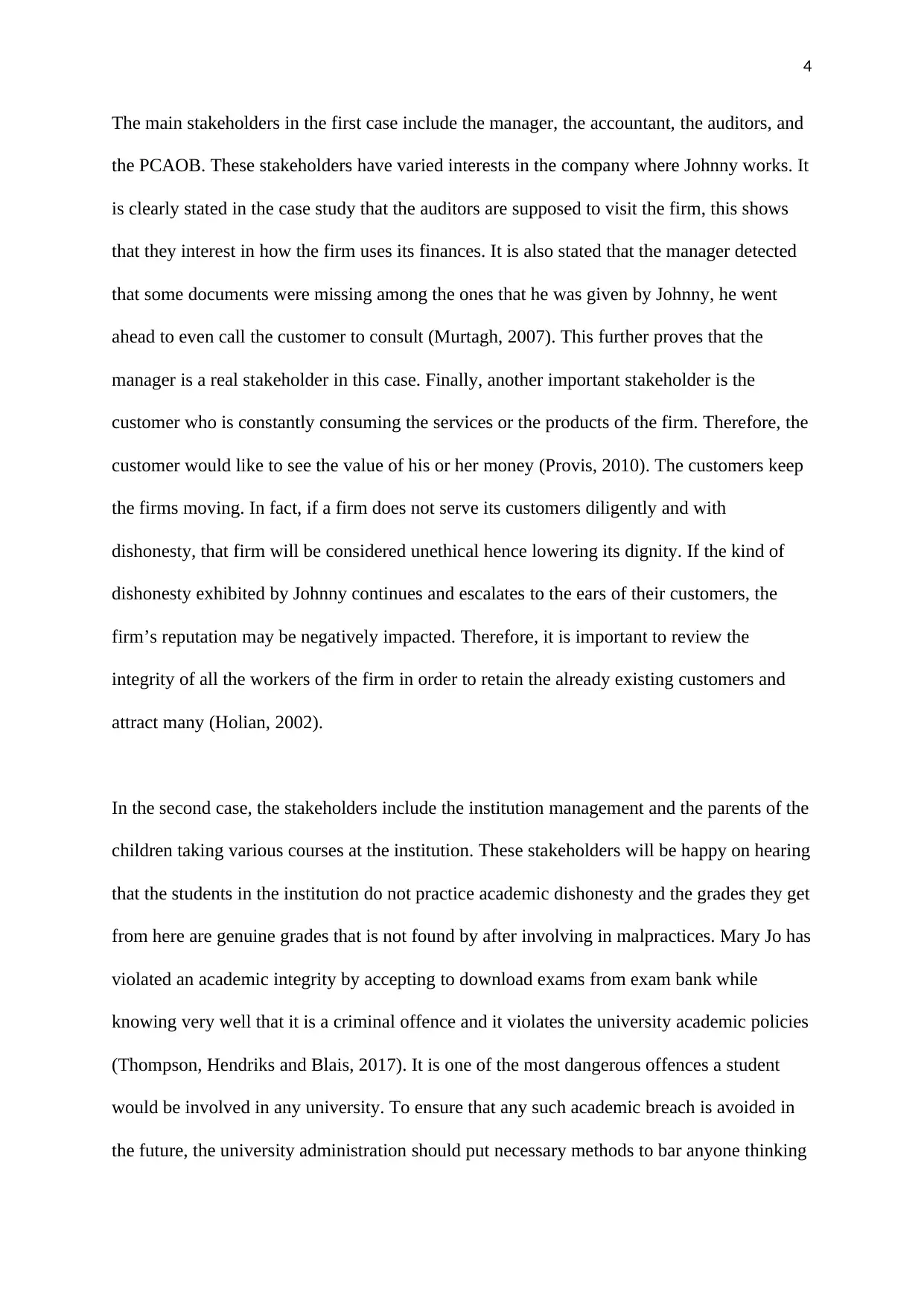
4
The main stakeholders in the first case include the manager, the accountant, the auditors, and
the PCAOB. These stakeholders have varied interests in the company where Johnny works. It
is clearly stated in the case study that the auditors are supposed to visit the firm, this shows
that they interest in how the firm uses its finances. It is also stated that the manager detected
that some documents were missing among the ones that he was given by Johnny, he went
ahead to even call the customer to consult (Murtagh, 2007). This further proves that the
manager is a real stakeholder in this case. Finally, another important stakeholder is the
customer who is constantly consuming the services or the products of the firm. Therefore, the
customer would like to see the value of his or her money (Provis, 2010). The customers keep
the firms moving. In fact, if a firm does not serve its customers diligently and with
dishonesty, that firm will be considered unethical hence lowering its dignity. If the kind of
dishonesty exhibited by Johnny continues and escalates to the ears of their customers, the
firm’s reputation may be negatively impacted. Therefore, it is important to review the
integrity of all the workers of the firm in order to retain the already existing customers and
attract many (Holian, 2002).
In the second case, the stakeholders include the institution management and the parents of the
children taking various courses at the institution. These stakeholders will be happy on hearing
that the students in the institution do not practice academic dishonesty and the grades they get
from here are genuine grades that is not found by after involving in malpractices. Mary Jo has
violated an academic integrity by accepting to download exams from exam bank while
knowing very well that it is a criminal offence and it violates the university academic policies
(Thompson, Hendriks and Blais, 2017). It is one of the most dangerous offences a student
would be involved in any university. To ensure that any such academic breach is avoided in
the future, the university administration should put necessary methods to bar anyone thinking
The main stakeholders in the first case include the manager, the accountant, the auditors, and
the PCAOB. These stakeholders have varied interests in the company where Johnny works. It
is clearly stated in the case study that the auditors are supposed to visit the firm, this shows
that they interest in how the firm uses its finances. It is also stated that the manager detected
that some documents were missing among the ones that he was given by Johnny, he went
ahead to even call the customer to consult (Murtagh, 2007). This further proves that the
manager is a real stakeholder in this case. Finally, another important stakeholder is the
customer who is constantly consuming the services or the products of the firm. Therefore, the
customer would like to see the value of his or her money (Provis, 2010). The customers keep
the firms moving. In fact, if a firm does not serve its customers diligently and with
dishonesty, that firm will be considered unethical hence lowering its dignity. If the kind of
dishonesty exhibited by Johnny continues and escalates to the ears of their customers, the
firm’s reputation may be negatively impacted. Therefore, it is important to review the
integrity of all the workers of the firm in order to retain the already existing customers and
attract many (Holian, 2002).
In the second case, the stakeholders include the institution management and the parents of the
children taking various courses at the institution. These stakeholders will be happy on hearing
that the students in the institution do not practice academic dishonesty and the grades they get
from here are genuine grades that is not found by after involving in malpractices. Mary Jo has
violated an academic integrity by accepting to download exams from exam bank while
knowing very well that it is a criminal offence and it violates the university academic policies
(Thompson, Hendriks and Blais, 2017). It is one of the most dangerous offences a student
would be involved in any university. To ensure that any such academic breach is avoided in
the future, the university administration should put necessary methods to bar anyone thinking
Paraphrase This Document
Need a fresh take? Get an instant paraphrase of this document with our AI Paraphraser
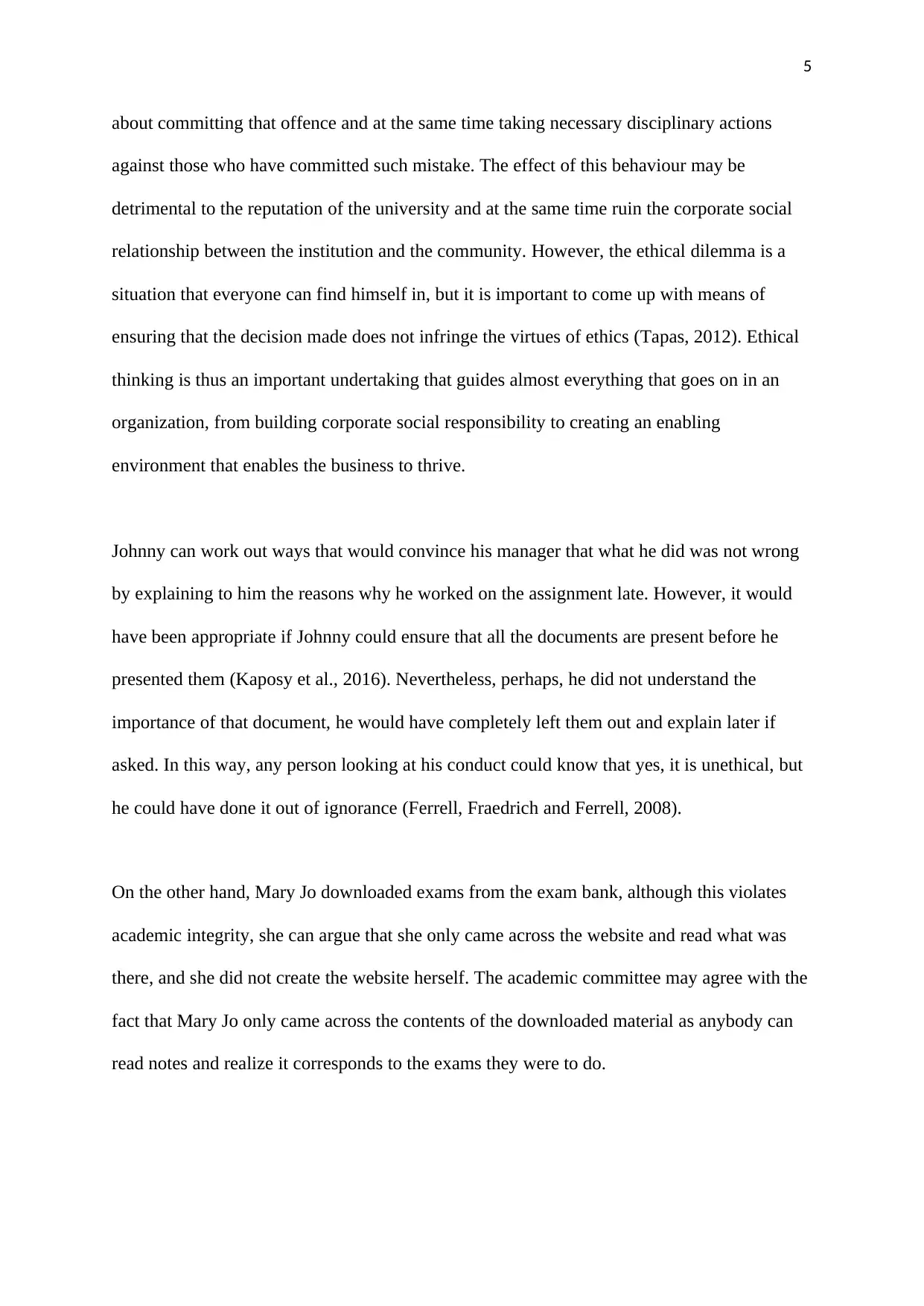
5
about committing that offence and at the same time taking necessary disciplinary actions
against those who have committed such mistake. The effect of this behaviour may be
detrimental to the reputation of the university and at the same time ruin the corporate social
relationship between the institution and the community. However, the ethical dilemma is a
situation that everyone can find himself in, but it is important to come up with means of
ensuring that the decision made does not infringe the virtues of ethics (Tapas, 2012). Ethical
thinking is thus an important undertaking that guides almost everything that goes on in an
organization, from building corporate social responsibility to creating an enabling
environment that enables the business to thrive.
Johnny can work out ways that would convince his manager that what he did was not wrong
by explaining to him the reasons why he worked on the assignment late. However, it would
have been appropriate if Johnny could ensure that all the documents are present before he
presented them (Kaposy et al., 2016). Nevertheless, perhaps, he did not understand the
importance of that document, he would have completely left them out and explain later if
asked. In this way, any person looking at his conduct could know that yes, it is unethical, but
he could have done it out of ignorance (Ferrell, Fraedrich and Ferrell, 2008).
On the other hand, Mary Jo downloaded exams from the exam bank, although this violates
academic integrity, she can argue that she only came across the website and read what was
there, and she did not create the website herself. The academic committee may agree with the
fact that Mary Jo only came across the contents of the downloaded material as anybody can
read notes and realize it corresponds to the exams they were to do.
about committing that offence and at the same time taking necessary disciplinary actions
against those who have committed such mistake. The effect of this behaviour may be
detrimental to the reputation of the university and at the same time ruin the corporate social
relationship between the institution and the community. However, the ethical dilemma is a
situation that everyone can find himself in, but it is important to come up with means of
ensuring that the decision made does not infringe the virtues of ethics (Tapas, 2012). Ethical
thinking is thus an important undertaking that guides almost everything that goes on in an
organization, from building corporate social responsibility to creating an enabling
environment that enables the business to thrive.
Johnny can work out ways that would convince his manager that what he did was not wrong
by explaining to him the reasons why he worked on the assignment late. However, it would
have been appropriate if Johnny could ensure that all the documents are present before he
presented them (Kaposy et al., 2016). Nevertheless, perhaps, he did not understand the
importance of that document, he would have completely left them out and explain later if
asked. In this way, any person looking at his conduct could know that yes, it is unethical, but
he could have done it out of ignorance (Ferrell, Fraedrich and Ferrell, 2008).
On the other hand, Mary Jo downloaded exams from the exam bank, although this violates
academic integrity, she can argue that she only came across the website and read what was
there, and she did not create the website herself. The academic committee may agree with the
fact that Mary Jo only came across the contents of the downloaded material as anybody can
read notes and realize it corresponds to the exams they were to do.
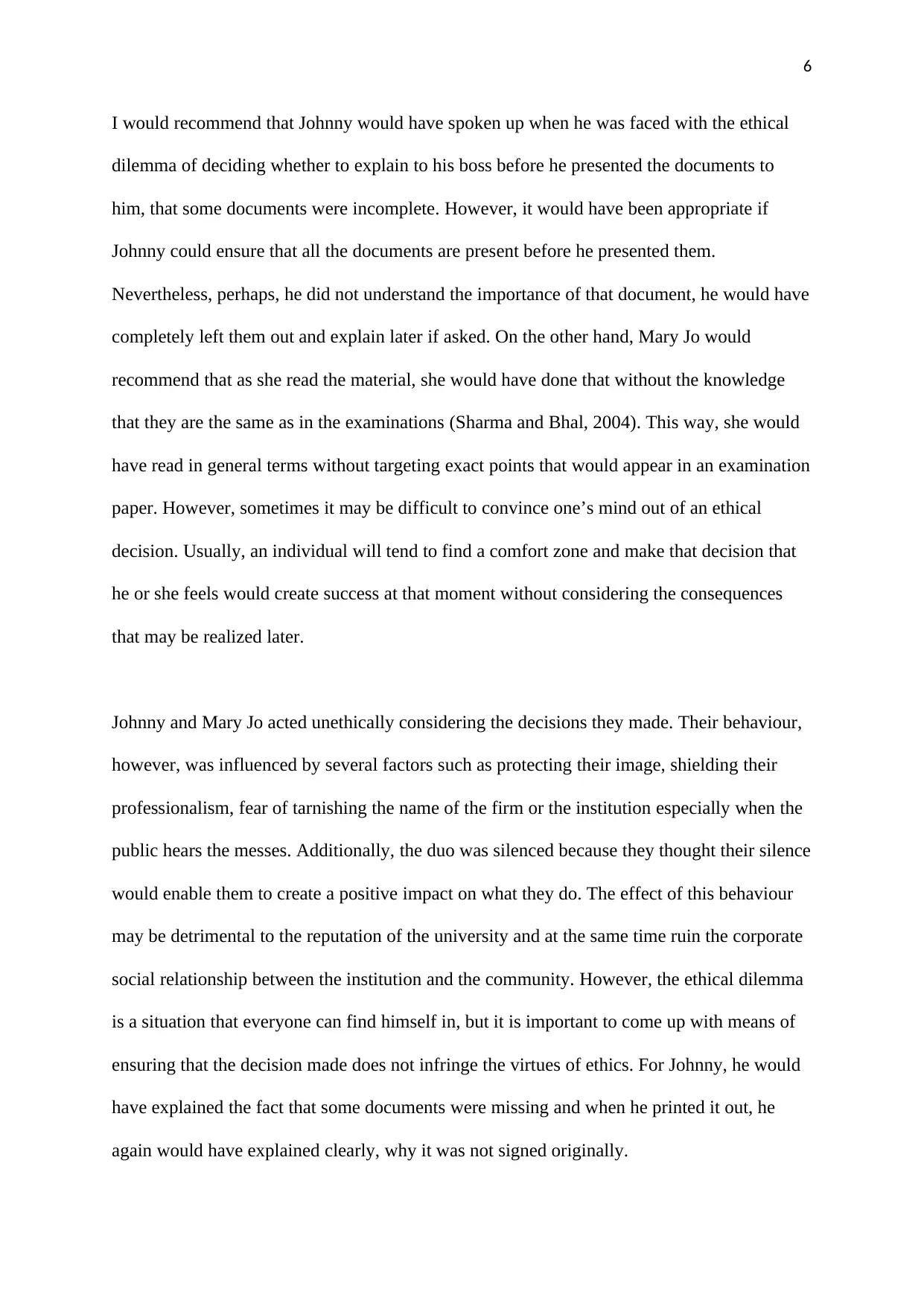
6
I would recommend that Johnny would have spoken up when he was faced with the ethical
dilemma of deciding whether to explain to his boss before he presented the documents to
him, that some documents were incomplete. However, it would have been appropriate if
Johnny could ensure that all the documents are present before he presented them.
Nevertheless, perhaps, he did not understand the importance of that document, he would have
completely left them out and explain later if asked. On the other hand, Mary Jo would
recommend that as she read the material, she would have done that without the knowledge
that they are the same as in the examinations (Sharma and Bhal, 2004). This way, she would
have read in general terms without targeting exact points that would appear in an examination
paper. However, sometimes it may be difficult to convince one’s mind out of an ethical
decision. Usually, an individual will tend to find a comfort zone and make that decision that
he or she feels would create success at that moment without considering the consequences
that may be realized later.
Johnny and Mary Jo acted unethically considering the decisions they made. Their behaviour,
however, was influenced by several factors such as protecting their image, shielding their
professionalism, fear of tarnishing the name of the firm or the institution especially when the
public hears the messes. Additionally, the duo was silenced because they thought their silence
would enable them to create a positive impact on what they do. The effect of this behaviour
may be detrimental to the reputation of the university and at the same time ruin the corporate
social relationship between the institution and the community. However, the ethical dilemma
is a situation that everyone can find himself in, but it is important to come up with means of
ensuring that the decision made does not infringe the virtues of ethics. For Johnny, he would
have explained the fact that some documents were missing and when he printed it out, he
again would have explained clearly, why it was not signed originally.
I would recommend that Johnny would have spoken up when he was faced with the ethical
dilemma of deciding whether to explain to his boss before he presented the documents to
him, that some documents were incomplete. However, it would have been appropriate if
Johnny could ensure that all the documents are present before he presented them.
Nevertheless, perhaps, he did not understand the importance of that document, he would have
completely left them out and explain later if asked. On the other hand, Mary Jo would
recommend that as she read the material, she would have done that without the knowledge
that they are the same as in the examinations (Sharma and Bhal, 2004). This way, she would
have read in general terms without targeting exact points that would appear in an examination
paper. However, sometimes it may be difficult to convince one’s mind out of an ethical
decision. Usually, an individual will tend to find a comfort zone and make that decision that
he or she feels would create success at that moment without considering the consequences
that may be realized later.
Johnny and Mary Jo acted unethically considering the decisions they made. Their behaviour,
however, was influenced by several factors such as protecting their image, shielding their
professionalism, fear of tarnishing the name of the firm or the institution especially when the
public hears the messes. Additionally, the duo was silenced because they thought their silence
would enable them to create a positive impact on what they do. The effect of this behaviour
may be detrimental to the reputation of the university and at the same time ruin the corporate
social relationship between the institution and the community. However, the ethical dilemma
is a situation that everyone can find himself in, but it is important to come up with means of
ensuring that the decision made does not infringe the virtues of ethics. For Johnny, he would
have explained the fact that some documents were missing and when he printed it out, he
again would have explained clearly, why it was not signed originally.
⊘ This is a preview!⊘
Do you want full access?
Subscribe today to unlock all pages.

Trusted by 1+ million students worldwide
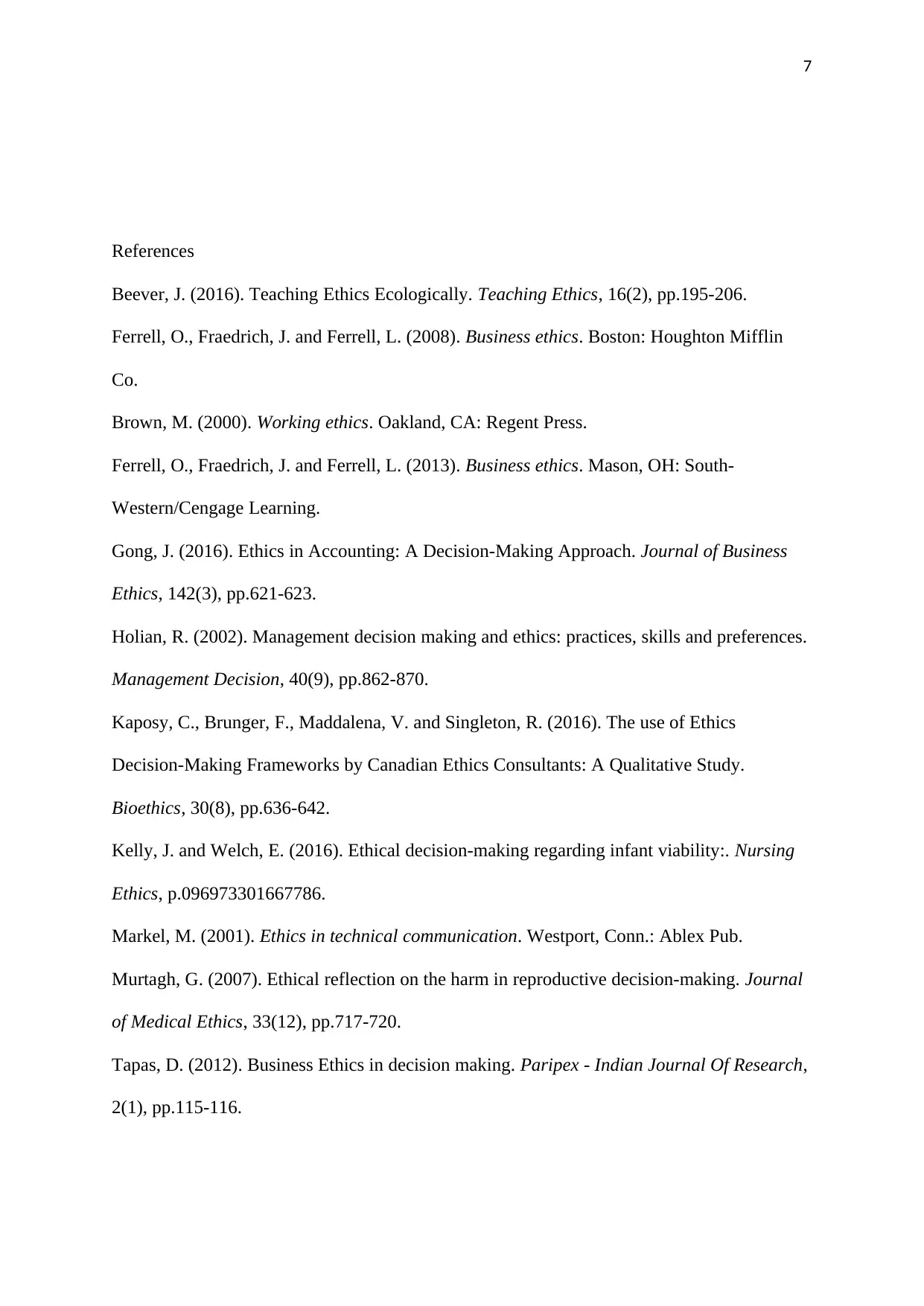
7
References
Beever, J. (2016). Teaching Ethics Ecologically. Teaching Ethics, 16(2), pp.195-206.
Ferrell, O., Fraedrich, J. and Ferrell, L. (2008). Business ethics. Boston: Houghton Mifflin
Co.
Brown, M. (2000). Working ethics. Oakland, CA: Regent Press.
Ferrell, O., Fraedrich, J. and Ferrell, L. (2013). Business ethics. Mason, OH: South-
Western/Cengage Learning.
Gong, J. (2016). Ethics in Accounting: A Decision-Making Approach. Journal of Business
Ethics, 142(3), pp.621-623.
Holian, R. (2002). Management decision making and ethics: practices, skills and preferences.
Management Decision, 40(9), pp.862-870.
Kaposy, C., Brunger, F., Maddalena, V. and Singleton, R. (2016). The use of Ethics
Decision-Making Frameworks by Canadian Ethics Consultants: A Qualitative Study.
Bioethics, 30(8), pp.636-642.
Kelly, J. and Welch, E. (2016). Ethical decision-making regarding infant viability:. Nursing
Ethics, p.096973301667786.
Markel, M. (2001). Ethics in technical communication. Westport, Conn.: Ablex Pub.
Murtagh, G. (2007). Ethical reflection on the harm in reproductive decision-making. Journal
of Medical Ethics, 33(12), pp.717-720.
Tapas, D. (2012). Business Ethics in decision making. Paripex - Indian Journal Of Research,
2(1), pp.115-116.
References
Beever, J. (2016). Teaching Ethics Ecologically. Teaching Ethics, 16(2), pp.195-206.
Ferrell, O., Fraedrich, J. and Ferrell, L. (2008). Business ethics. Boston: Houghton Mifflin
Co.
Brown, M. (2000). Working ethics. Oakland, CA: Regent Press.
Ferrell, O., Fraedrich, J. and Ferrell, L. (2013). Business ethics. Mason, OH: South-
Western/Cengage Learning.
Gong, J. (2016). Ethics in Accounting: A Decision-Making Approach. Journal of Business
Ethics, 142(3), pp.621-623.
Holian, R. (2002). Management decision making and ethics: practices, skills and preferences.
Management Decision, 40(9), pp.862-870.
Kaposy, C., Brunger, F., Maddalena, V. and Singleton, R. (2016). The use of Ethics
Decision-Making Frameworks by Canadian Ethics Consultants: A Qualitative Study.
Bioethics, 30(8), pp.636-642.
Kelly, J. and Welch, E. (2016). Ethical decision-making regarding infant viability:. Nursing
Ethics, p.096973301667786.
Markel, M. (2001). Ethics in technical communication. Westport, Conn.: Ablex Pub.
Murtagh, G. (2007). Ethical reflection on the harm in reproductive decision-making. Journal
of Medical Ethics, 33(12), pp.717-720.
Tapas, D. (2012). Business Ethics in decision making. Paripex - Indian Journal Of Research,
2(1), pp.115-116.
Paraphrase This Document
Need a fresh take? Get an instant paraphrase of this document with our AI Paraphraser
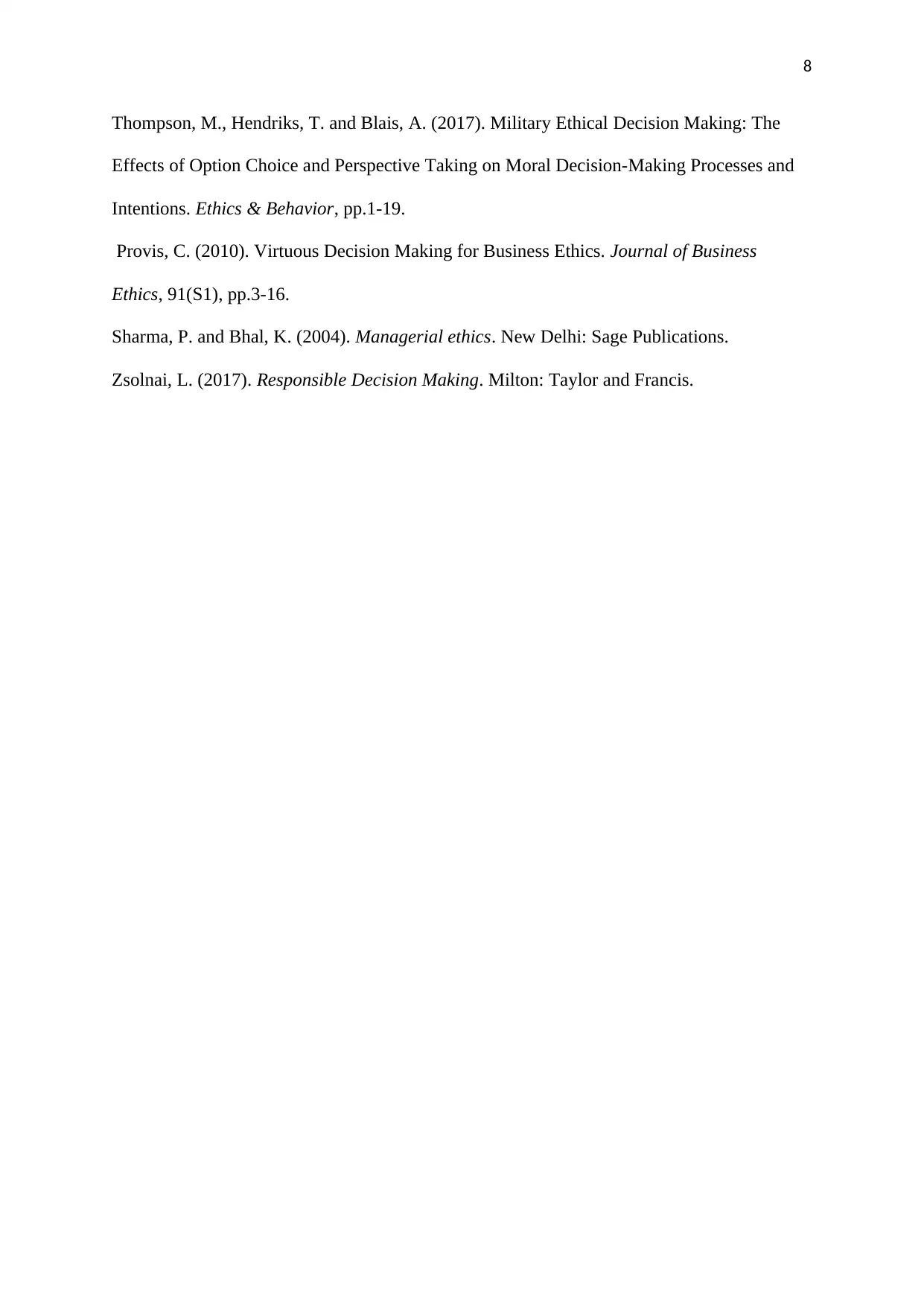
8
Thompson, M., Hendriks, T. and Blais, A. (2017). Military Ethical Decision Making: The
Effects of Option Choice and Perspective Taking on Moral Decision-Making Processes and
Intentions. Ethics & Behavior, pp.1-19.
Provis, C. (2010). Virtuous Decision Making for Business Ethics. Journal of Business
Ethics, 91(S1), pp.3-16.
Sharma, P. and Bhal, K. (2004). Managerial ethics. New Delhi: Sage Publications.
Zsolnai, L. (2017). Responsible Decision Making. Milton: Taylor and Francis.
Thompson, M., Hendriks, T. and Blais, A. (2017). Military Ethical Decision Making: The
Effects of Option Choice and Perspective Taking on Moral Decision-Making Processes and
Intentions. Ethics & Behavior, pp.1-19.
Provis, C. (2010). Virtuous Decision Making for Business Ethics. Journal of Business
Ethics, 91(S1), pp.3-16.
Sharma, P. and Bhal, K. (2004). Managerial ethics. New Delhi: Sage Publications.
Zsolnai, L. (2017). Responsible Decision Making. Milton: Taylor and Francis.
1 out of 8
Related Documents
Your All-in-One AI-Powered Toolkit for Academic Success.
+13062052269
info@desklib.com
Available 24*7 on WhatsApp / Email
![[object Object]](/_next/static/media/star-bottom.7253800d.svg)
Unlock your academic potential
Copyright © 2020–2025 A2Z Services. All Rights Reserved. Developed and managed by ZUCOL.





